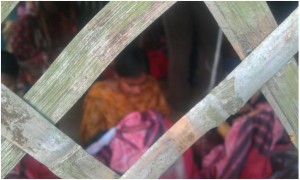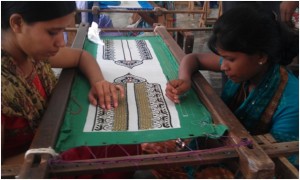– Guest post by Nameera Nuzhat, intern at the Social Innovation Lab
On my fourth day as an intern at BRAC, I made a trip to Manikganj, my first ever BRAC field visit. In fact, it was my first ever visit anywhere outside of the typical touristy holiday trips to Sylhet and Cox’s Bazaar. I got to see many BRAC programmes in action; a meeting of pregnant women with the Shastho kormi and Shastho Shebika, eye examination and TB patients consultation and child nutrition class conducted by shebikas. Also saw a human rights and legal education class; a microfinance village organization meeting; a WASH shebika conducting a sanitation and hygiene meeting; community discussions known as Polli Somaj meeting, pre-primary and primary schools as well as Kishori clubs, a recreational space designed for peer-to-peer interaction and a place where teenagers, especially girls, could come and discuss social issues.
As a newcomer to BRAC, visiting ten programmes in one day was an overwhelming experience! I walked, talked and breathed BRAC for the entire day and got a real sense of BRAC’s presence in villages around the country. Right after I joined as an intern I was told by many within BRAC that one can never understand what BRAC truly stands for until they visit the programs. Just reading about the programs was absolutely not sufficient. BRAC operates hundreds of programmes in 70000 villages and 2000 slums across Bangladesh so in order to understand the scale and scope of these diverse components, a deeper understanding is almost mandatory to make any concrete conclusions. This is probably the reason why BRAC employees – from program coordinators to directors, valued the stream of information spawned from every field visit.
So when my supervisor Maria May told me about this visit organized by Aarong, I was up for it right away especially because Aarong has been one of the more novel social enterprises we have seen over the years.
Aarong was set up in 1978 and supports over 65,000 artisans of which at least 80% are women. It has grown from one factory in Manikganj to thirteen Ayesha Abed Foundation Centres and 600 sub-centres. The unique ethnic arts and crafts of the region are being successfully promoted through exiting channels in the marketplace. Now Aarong is the most popular, most esteemed retail chain in the country producing high quality and fashionable products ranging from clothing, household items, leather goods, jewellery and many more. The enterprise ploughs fifty per cent of its profits into BRAC’s development programmes and the remaining is pumped back into Aarong’s revenue stream. It is the twenty or so enterprises and investments like Aarong that form the backbone of BRAC’s sustainable funding model. A collaborative system , where surplus making enterprises and investments support development programmes while wilfully gaining from BRAC’s undying reputation.
However, in characteristics the enterprises are like a conventional business entity. Aarong is detached from BRAC in its management and administration and the link remains only in the contribution of finances. As such, over time the craftsperson that took up employment with Aarong were not naturally eased into appropriate development programmes as BRAC clients. A huge chunk of artisans who could use BRAC support remained outside BRAC programmes.
Aarong management wanted to enable the access of these artisans to different development programmes of BRAC for example the artisan’s children should be enrolled in BRAC schools, their families be able to take advantage of BRAC health, sanitation and hygiene programs and the workers themselves should have easy access to legal counsel from the HRLS.
So, on the 5th of January 2012, with help from the Social Innovation Lab, Aarong organized a brainstorming session with the directors of BRAC. Two main issues came forth through the dialogue. Firstly, Aarong needed more comprehensive information from all artisans working for it under independent producers; and secondly, it had to identify how it could help them appropriately through BRAC programmes.
 Following the initial session, all the participating programmes provided Aarong with contact persons who would represent the individual programme in this effort to bring the left out artisans under the BRAC umbrella. As a first step, my field-visit to Manikganj was organized. The objectives of the tour were to inform BRAC staff about Aarong’s operations, educate Aarong staff about BRAC programme activities and initiate a process of ideas synchronization between everyone working on this.
Following the initial session, all the participating programmes provided Aarong with contact persons who would represent the individual programme in this effort to bring the left out artisans under the BRAC umbrella. As a first step, my field-visit to Manikganj was organized. The objectives of the tour were to inform BRAC staff about Aarong’s operations, educate Aarong staff about BRAC programme activities and initiate a process of ideas synchronization between everyone working on this.
Following the trip, the BRAC representatives and Aarong officials drafted a program designed for the Aarong artisans so that the workers along with their families could be benefitted from BRAC programmes .The next step is the presentation of this design in front of all the Directors of BRAC and Aarong, and following their approval, the program will be launched in due time.
It was exciting for me to witness the process and the ways in which the programme needs were assessed. It’s a proud feeling indeed, to be part of a project from its very conception! In a year or two, I look forward to reading about the success of the BRAC-Aarong collaboration project.
